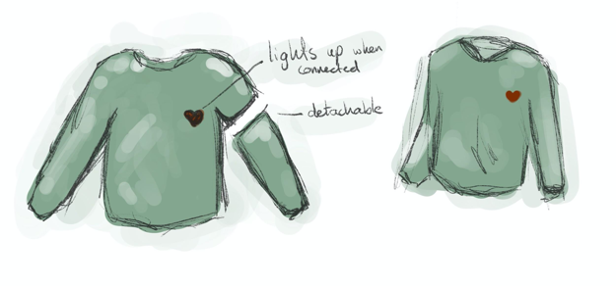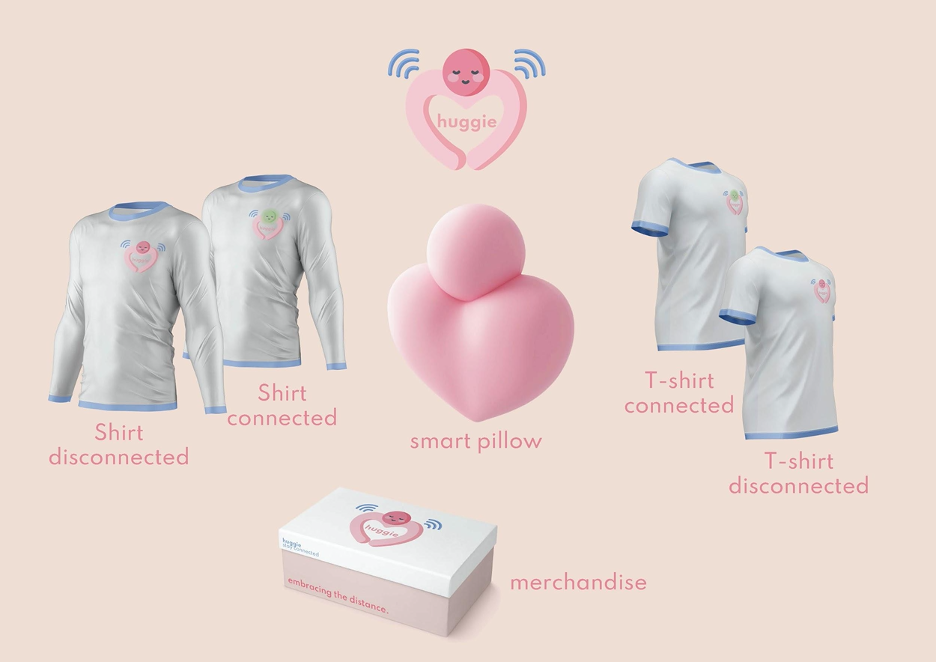In our research skills course Rapid Prototyping, taught by Simone Ashby, students learn how to create prototypes to answer research questions. In this blog post, Eveline de Groot, Laura Beamuz, Markus Pandrea, and Nour Tanak, who took this course in the fall of 2020, talk about their group assignment, and the prototype they’ve created.
huggie – embracing the distance
For the Rapid Prototyping course, the assignment was to formulate a research question that addresses a specific problem space, and to develop a prototype that impacts the world. Looking at present-day world problems, we unanimously agreed on COVID-19 and elderly as a focus. Our assumption was that the elderly feel lonely and isolated, which has become more evident as the COVID-19 pandemic shifted to the forefront of their daily lives. We experienced this first hand with our own grandparents, since they were forced to socially distance themselves from their loved ones. This social distancing led to the absence of physical affection, which is greatly missed. Our focus point became haptic sensory technologies and how these could be of help during social distancing. In the end, we came up with the following research question: How can remote haptic sensory technologies decrease feeling of loneliness among the elderly?
We saw this assignment and this research question as an opportunity to get out of our comfort zones, as we set out to create a prototype of a product with not just digital components, but also physical parts. Throughout the course, we first engaged in individual parallel prototyping (see sketches below), after which we combined our best findings and ideas into a collectively iterative prototype .
Sketches of individual prototypes
Through several iterations (low, medium, and high fidelity) and feedback moments with Simone, we converged to a prototype that we came to call huggie. Huggie is a smart pillow (see pictures below) that connects people remotely through a sensory and tactile experience.
 Medium fidelity prototype. This prototype was merged from the individual low fidelity prototypes during the parallel session, into one iterative prototype.
Medium fidelity prototype. This prototype was merged from the individual low fidelity prototypes during the parallel session, into one iterative prototype.
Besides a pillow, huggie also features a shirt (see high-fidelity prototype below). Both the pillow and the shirt are made of smart fabrics. The smart fabric of the pillow simulates the heartbeat and temperature of your loved ones and takes in the pressure of their hug. This data is sent wirelessly to the compatible, connected shirt. When one person hugs the pillow, the other person wearing a compatible shirt feels the pressure of the hug, heartbeat, and temperature of the other, bringing them closer to each other despite the distance. The lit-up huggie logo indicates that you and your loved one are connected over distance.
High fidelity prototype. The complete huggie concept with the logo, pillow, shirt, and box design.
We, Eveline de Groot, Laura Beamuz, Markus Pandrea, and Nour Tanak, as a group, had a lot of fun exploring the different ways to prototype and develop something we had come to love so passionately. Huggie is a product of love, born from the love we have for our grandparents struggling with the isolation.
With huggie we are embracing the distance.
huggie launch video


